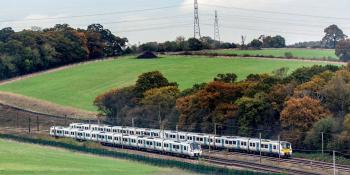
Keith Fender
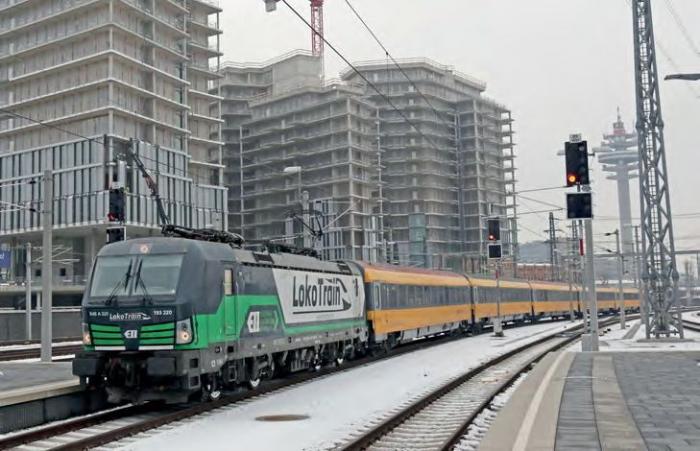
EUROPE
INTERNATIONAL EXPANSION FOR REGIOJET
Czech open access operator Regiojet expanded its network significantly from 10 December, introducing four train pairs on most days (three on Sundays) between Prague and Vienna. In Austria the services are operated in conjunction with Graz-based Graz-Köflacher Bahn (owned by the Austrian government but run as a ‘private’ railway), which provides train crew between Vienna and Břeclav. Regiojet now offers eight trains daily between Prague and the Czech Republic’s second city, Brno (the four Vienna train pairs, plus three between Prague and the Slovak capital Bratislava, and one Brno-Prague train pair). This breaks Czech national operator ČD’s grip on this key route, which has seen only limited competition until now, unlike the Prague – Olomouc – Ostrava corridor, which now has four operators, three of them open access. The Regiojet services (which unlike the ČD / ÖBB Railjet services have no restaurant cars) are largely formed of 1980s-vintage former ÖBB coaches, originally sold by ÖBB for use by Regiojet when it was only operating in the Czech Republic and Slovakia.
Regiojet is buying eight Traxx MS electric locos from Bombardier; when originally announced in early 2017, these were due to be in service from late 2017. In practice, the first of them was being completed by Bombardier at its factory in Kassel, Germany in early March 2018, and they are unlikely to enter service before June. Until the Traxx locos are delivered, Regiojet is sub-leasing Vectron MS locos owned by ELL from Slovak open access freight operator Loko Train.
INTERNATIONAL PLANS FOR LEO EXPRESS
Leo Express, the second biggest private Czech open access operator after Regiojet, has announced plans to expand internationally, to neighbouring Poland and Germany (in August 2017 it became the operator of the former Locomore open access service in Germany, in conjunction with long-distance bus operator Flixbus). Leo Express has announced plans to run Prague – Berlin trains from December, using leased rolling stock which, according to local media reports, is likely to be second hand Alstom Lint DMUs.
Leo Express had planned to operate services into Poland several years ago, but delays obtaining the operating licence in Poland meant this did not happen as quickly as expected – although its already intensively-used fleet of five Stadler Flirt EMUs has approval for use in Poland, and the first service between Prague and Kraków is due to start in April. Leo Express has announced it expects to use its three new EMUs being built by CRCC in China from late 2018, as part of plans to expand domestic services as well. As these trains are not yet delivered or approved for use in the Czech Republic, this may be optimistic.
AUSTRIA
WESTBAHN’S EXTRA TRAINS SERVE CENTRAL VIENNA
After adding 10 more Stadler KISS double deck EMUs to its fleet during 2017 (one six-car and nine four-car sets in a contract worth around €130 million), Austrian open access operator Westbahn launched an expansion of its services between Salzburg and Vienna in December 2017. Rather than one train hourly to Vienna’s Westbahnhof station, the operator now offers a second service each hour to Wien Praterstern, to the north of the city centre.
The new services are routed via the underground cross-city route, rebuilt in the 1960s for S-Bahn services, between Wien Meidling and Wien Praterstern, serving the regional/S-Bahn underground platforms at the main station Wien Hauptbahnhof on the way. Westbahn started services between Freilassing in Germany, Salzburg and main stations to Vienna Westbahnhof in 2011, with seven six-car KISS EMUs, although services on the short section between Freilassing and Salzburg ceased two years later (they appear to have only existed to enable the service to operate as an international open access service in the first place, and initially Freilassing was used to stable trains whilst Salzburg Hbf was being rebuilt). Westbahn, which is largely privately owned (French Railways, SNCF, owns 17.4%), made a profit on an EBITDA basis of €10.6 million in 2016, with sales of €56.6 million. It is pushing for paths to enable services to operate south of Vienna.
GERMANY
SIEMENS LAUNCHES SMARTRON FOR GERMAN FREIGHT OPERATORS
Siemens has added a new electric loco to its product range, which currently only includes multiple variants of the Vectron. The new loco, the Smartron, looks like the Vectron (indeed the loco Siemens is offering as the Smartron demonstrator was built as a Vectron in 2017). However, the Smartron loco is much more standardised than the Vectron platform, which can incorporate multiple traction currents, multiple signalling systems and the country-specific requirements of most EU countries
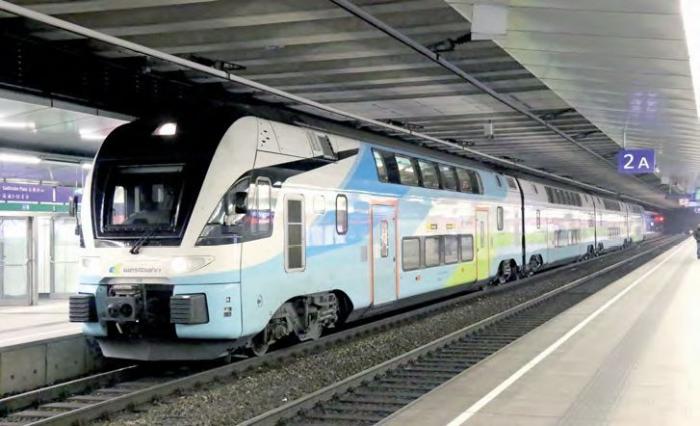
Siemens says the Smartron is designed for freight operators in Germany, and the loco has already received the full approvals needed to operate there. It is equipped with both PZB and LZB signalling systems used on the German network (but not European Train Control System). The 140km/h, 15kV AC, 83-tonne locos have a power rating of 5.6MW, which is lower than most Vectrons and the earlier Eurosprinter range of locos, but is exactly the same as the main competitor, the Bombardier Traxx AC design. It appears Siemens is attempting to compete not only with the Traxx but also the large numbers of second hand 15kV AC locos in use with German freight operators or leasing companies.
Siemens intends to offer the new loco with a standardised contract, so they will all cost the same and the contract terms will be standard between customers. To emphasise this approach, Siemens has also said the locos will all be delivered in the same ‘Capri Blue’ livery. Siemens will offer maintenance services for those customers who want this.
HUNGARY
GYSEV VECTRONS IN SERVICE
Austro-Hungarian operator GySEV has bought nine Vectron MS locos from Siemens. The locos were supplied in two variants. Three tri-voltage (25kV AC / 15kV AC / 3,000V DC) locos are equipped for use in all Hungary’s neighbouring EU countries plus Germany, Czech Republic and Slovenia. Six dual-voltage (25kV AC / 15KV AC) locos have more limited international approval: the last four are equipped with diesel ‘last-mile’ engines. All are now in service, although some of the Class 471.5 tri-voltage versions are on hire to Austrian freight operator Wiener Lokalbahn and used on services between Germany and Hungary. The order was valued at €34.2 million and was entirely funded by a loan from the EU. GySEV is using most of the six dual-voltage Class 471.0 locos to operate inter-city services between Sopron / Szombathely and Budapest. These trains also include newly-refurbished former Austrian Railways (OBB) coaches branded with GySEV’s new inter-city brand Raabercity.
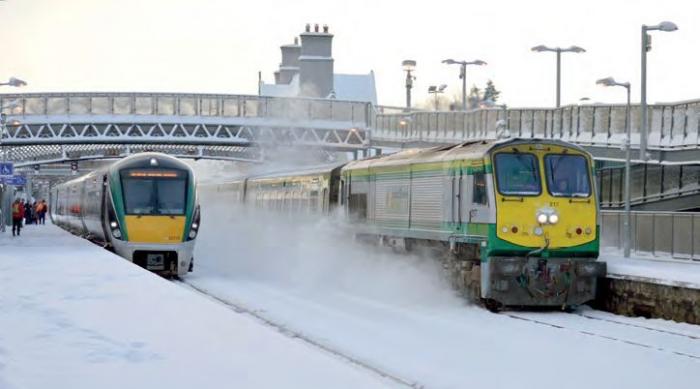
IRELAND
EMMA AND SNOW SHUT IARNRÓD ÉIREANN
The whole IÉ network was suspended on Friday 2 March due to heavy snow – so unusual in Ireland that IÉ does not possess a snow plough! Combined with the subsequent effects of Storm Emma, this caused damage and widespread flooding. In some areas, snow drifted to a height of a metre or more and rail-road vehicles with mechanical shovels had to be employed to clear tracks. Some services recommenced during the evening of 3 March whilst most routes, except some of the branches, were operating by Sunday 4 March.
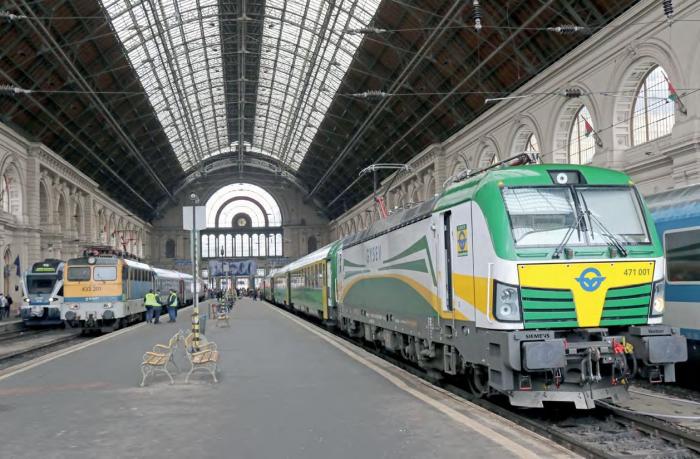
The DART line between Dublin Pearce and Greystones was disrupted, with flooding between Seapoint and Salthill and at Kilcoole (south of Greystones on the Rosslare line), where the alignment was damaged by the storm. The Western Rail Corridor between Ennis and Limerick had also been flooded from 27 January onwards, before Storm Emma, when water rose above track level at Ballycar. Serious flooding occurred on this recently reopened route in 2016, resulting in a closure lasting several months. Tim Casterton
ITALY
US INVESTORS BUY NTV
Italian open access high-speed operator NTV was (as we reported in ‘Europeview’, February) planning a stock market listing via an Initial Public Offering (IPO) in early 2018. This plan was superseded in January when major New York-based investment company Global Infrastructure Partners (GIP) made an offer for the entire company, valuing it at $1.94 billion. This was accepted quickly, with a deal finalised in mid-February.
NTV has been operating since 2012 and has a fleet of 25 Alstom-built AGV 300km/h trains plus a new fleet of 17 non-tilting 250km/h Pendolino Evo EMUs, also built by Alstom in Italy, which are currently being delivered.
NTV has historically owned the trains and has long-term maintenance contracts for them with Alstom. It is unclear whether the new owner intends to retain ownership of the train fleets or sell them to a leasing company. GIP has made other major transport investments previously: in Australia it owns freight operator Pacific National, whilst in the UK it owns both Edinburgh and London Gatwick airports.
FRANCE
GOVERNMENT ANNOUNCES MAJOR RAIL REFORMS
Eleven days after the publication of a major government review that suggested 9,000km of rural railway lines should be closed, the French prime minister, Edouard Philippe, announced his government’s response on 26 February.
He said the line closures would not be supported, but set out wide-ranging reforms of national operator SNCF and the French rail industry, with the aim of reducing costs, improving service to passengers and securing a long-term future for SNCF in a changing market. M. Philippe made the announcement at his official residence, the Hôtel de Matignon, and in presenting the plan said change needed to be ‘profound’ and needed to ‘happen quickly’.
He invited the trade unions to join the process and said a new SNCF was needed, ruling out the ‘British’ model of fragmentation and calling for a ‘pacte ferroviaire’, or new railway pact. He also explicitly ruled out privatisation or changes to pension arrangements, and stressed that investment in the rail network would increase, not decrease.
Whilst offering the prospect of change and a more secure future, the prime minister also made it clear France could no longer afford a railway that is 30% more expensive than its neighbours and which regularly offers poor performance (during the last year SNCF has experienced multiple incidents damaging its reputation – some of them outside its direct control – which have severely disrupted Paris RER services, plus major signal failures at Paris stations which led to well-publicised major disruption). The prime minister stated the rail industry was costing the government (national and regional) over €14 billion a year (22% more than a decade ago), and that this amount represented more than the entire country spends on policing.
M. Philippe said successive French governments held part of the responsibility for the state of SNCF’s finances, by allowing or encouraging investment and then moving it off the government’s books. The debt was moved into the infrastructure manager RFF (Réseau Ferré de France), created in 1997 largely to manage the debt not the infrastructure (the latter was managed by SNCF under contract); this was part of efforts to enable France to meet the ‘Maastricht’ criteria for entry into the Euro. The prime minister stated the level of the debt and the rate at which it has grown (‘from €20 billion to nearly €50 billion in 20 years’) now poses a threat to the entire French rail network and that it ‘threatens to engulf the entire system’. Interest payments alone on the existing debt amount to €1.5 billion per year.
In the last decade SNCF has tried alternative sources of finance; the new LGV L’Océane that opened in July 2017 was partly privately-funded (42% of €9 billion funded via borrowing), but it still had €1 billion of SNCF Réseau funding and around €3 billion of direct national and regional government funding. As a concession, it has contracts requiring 50-year use of the line at access charges that are higher than average.

In danger of closing thanks to years of deferred infrastructure maintenance: SNCF DMU No X73574 at Roscoff in Brittany (due south of Plymouth) on 27 February 2018. The 28km Morlaix to Roscoff line is considered by campaigners to be in severe danger of closure, as lack of maintenance means train speeds are very low and what local campaigners say is a ‘derisory’ service level means only 50,000 passengers are carried annually, despite Roscoff being a major port and tourist destination. Roscoff lost direct trains to Paris in 1985, but Morlaix at the other end of the branch now is just over three hours from Paris by TGV thanks to the new LGV BPL high-speed line, which opened (to Rennes) in 2017. Keith Fender
TIMED PROGRAMME FOR REFORM
The reform plan set out by the government followed two major reports commissioned by the new government looking at French rail investment and the operation of the rail market in France.
The Prime Minister and his Transport Minister (former SNCF Strategy Director and CEO of Paris metro operator RATP) Mme Elisabeth Borne set out a timed programme to enact the reforms, which were discussed with both SNCF senior managers and union leaders days before the announcement.
The government appears to be using the same methods it used to successfully change France’s Labour Code during 2017: setting out its plans, consulting on them (a flurry of consultations is planned before the summer) and then enforcing change via decrees rather than new acts of parliament. This is faster, and President Emmanuel Macron’s En Marche movement has an absolute majority in the French Parliament, meaning the decrees cannot be overturned. An enabling law to make the rail reform possible is due to be debated by the French Parliament from March onwards.
INFRASTRUCTURE SPENDING’S CITY FOCUS
The first report by the newly-established Conseil d’Orientation des Infrastructures (Infrastructure Council – COI), chaired by Philippe Duron (who had previously undertaken a review of Intercités for the Hollande government in 2015), was published on 1 February. It recommended an investment programme for surface transport including rail over the next two decades that notably includes only one section of new high-speed line (the extension from Bordeaux to Toulouse). It does support some new sections of line between Marseille and Nice (where an earlier plan to build a high-speed line has effectively been dropped).
Electrification, including schemes underway, is largely not supported, with the COI arguing that new bi-mode trains and potentially new energy sources such as hydrogen fuel cells mean there is insufficient benefit to justify the expenditure. Much of the rail investment recommended is in cities (especially Paris, Lyon, Marseille and Bordeaux) to add capacity or remove historic bottlenecks; a new through station for Marseille is recommended.
This report largely fits with the policy priorities of President Macron, as set out in Rennes when he opened the new LGV-BPL high-speed line in July 2017; he prioritised local and regional transport investment, and effectively ruled out new high-speed line development. Though the new Mont Cenis base tunnel linking Lyon and Turin has escaped cancellation, thanks to prior treaty commitments to the Italian government, the COI does not support the planned high-speed line from the new tunnel to Lyon, meaning much of the journey time reduction envisaged between France and Italy won’t be possible.
The Duron report sets out three scenarios for investment to 2037, with the ‘steady state’ option requiring €48 billion: this would maintain the current network but deliver few enhancements before the mid-2030s or later. A second scenario costing €60 billion would see more enhancements delivered during the 2020s/2030s, whilst a third option costing €80 billion would largely see the same enhancements achieved, but much faster (by 2032). The government has yet to announce its preferred option and will have to do so in the context of balancing multiple other areas of public expenditure.
30% MORE EXPENSIVE
Ten days later, on 11 February, former Air France CEO Jean-Cyril Spinetta published his report (commissioned by the new government in October 2017) on the operation of the French railway market and SNCF, and how the French rail sector can be opened to competition (this is planned in line with EU rules for both regional tendering and open access passenger competition). A key objective for M. Spinetta to consider was how to establish a viable future for SNCF given its historic debt and working practices that crucially would not require additional government funding.
The Spinetta report points out that, in common with most developed countries, rail usage (trips) has declined in the last 50 years, with private cars being the main alternative used. It also points out that most (85%) of the French population now lives in cities or urban areas, which is the exact opposite of the situation 150 years ago when the rail network was initially built – although rail usage measured in passenger kilometres has increased substantially since the 1950s as a result of the construction of the high-speed network linking the cities most people now live in.
M. Spinetta identified SNCF’s costs (30% higher than neighbouring countries such as Germany) and poor productivity, plus the huge debt held by SNCF Réseau, as fundamental problems, and recommended a series of changes to working conditions and the reduction in SNCF employee numbers in coming years through voluntary redundancy. M. Spinetta says overall subsidy for operation of the rail network from both central and regional government is over €10 billion (with more money for infrastructure) and that €1.7 billion of this is attributed to providing services on the least-used 10,000km of the network – which he says is used by only 2% of passenger journeys. Many of the least-used parts of the French rail network use outdated signalling, requiring staffed stations whenever trains are operating (however infrequently). The lack of investment in the last 30 years is readily apparent compared to many other western European countries (such as the UK, Germany, Netherlands or Sweden); stations often retain staffed ticket offices despite there being few trains and ticket machines being provided.
LINE CLOSURES?
The Spinetta report suggested France was the only European country to have retained so many antiquated and little-used rural railway lines, a comment greeted with incredulity by industry observers in the French railway press. M. Spinetta suggested up to 9,000km of the approximately 30,000km network should simply be closed. It took the government less than a fortnight to say this would not happen, although by placing the final decision in the hands of the Regions (which fund all the local passenger services now) it is entirely possible multiple lines will close over the coming years anyway.
Experience in Germany shows that regional governments faced with limited finances often prioritise other public services such as health or education over funding lightly-used rail services; by devolving the decision to the regions the national government avoids most of the blame. Germany has also seen significantly reduced cost of provision by tendering operation of local rail services; to date SNCF has resisted tendering, despite some French regions asking for it. The Spinetta report recommends tendering for regional services should start from 2021.
NEW COMPANY
The French government is basically offering the rail industry a new deal – reduce costs significantly and in return the government will restructure SNCF back into a corporate structure as a National Corporation with public capital (effectively back to its 1938 to 1983 status as a state-owned company). The government would assume responsibility for much of the debt, largely built up in building high-speed lines whilst not reforming or investing in the rest of the industry to reduce costs. The new company envisaged would be allowed to borrow, but within normal commercial limits, as unlike the current structure it could become insolvent. The government believes such a new company will overcome legal problems inherent to the current structure in terms of EU law, and will have the benefit of removing the new SNCF from the immediate influence of the government and other politicians.
ADIEU CHEMINOTS?
The package of reforms unveiled by the Prime Minister on 26 February included ending the special quasi civil service ‘Cheminot’ (railway worker) status of most, but not all, SNCF employees, applying to new employees from later this year at least (around 130,000 employees in 2018 have the status). The Cheminot status effectively means such employees have a job for life and, depending on their role, a retirement age between 50 and 55 (rising to 52 to 57 from 2024 under previously agreed changes). The Cheminot status dates back to the pre-World War 2 creation of SNCF, but similar retirement options exist in other parts of the French public sector such as education. The government proposals specifically do not include changes to existing employees’ pensions, suggesting an element of caution in the overall approach.
Other European operators have phased in changes to terms and conditions for rail employees, often replacing arrangements dating back to the 1950s or earlier. In Germany, railway staff lost their Beamter (civil service) status from 1994, whilst in the UK since privatisation there have been many changes, especially for new employees. The French government’s announcement inevitably provoked outrage among some of SNCF’s trade unions, with threats of national strikes from late March onwards if the proposals are not changed; the plan by the government to use decrees to implement the planned change was seen as being particularly provocative. Opinion polls conducted two weeks after the policy announcements suggested widespread public support for the government’s reform plans.
